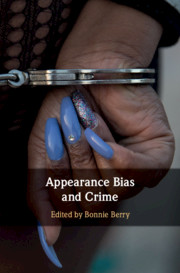Book contents
- Appearance Bias and Crime
- Appearance Bias and Crime
- Copyright page
- Dedication
- Epigraph
- Contents
- Biographical Sketches of Contributors
- Acknowledgments
- Introduction
- Part I Unattractiveness, Criminality, and Victimization
- Part II Race, Ethnicity, and Nationality as Targeted Identities
- Part III The Process of Social Control as Influenced by Appearance
- 6 Becoming and Being a Woman Prisoner
- 7 The Impact of Victim Attractiveness on Victim Blameworthiness and Defendant Guilt Determination in Cases of Domestic and Sexual Assault
- 8 Do Attractive Women “Get Away” with Traffic Violations? An Observational Study of Police Responses to Traffic Stops
- 9 The Police “Presence”
- Part IV Identifying Terrorists, Mistakenly or Not, by Appearance
- Part V Very Visible Differences
- Conclusion
- Index
- References
8 - Do Attractive Women “Get Away” with Traffic Violations? An Observational Study of Police Responses to Traffic Stops
from Part III - The Process of Social Control as Influenced by Appearance
Published online by Cambridge University Press: 22 March 2019
- Appearance Bias and Crime
- Appearance Bias and Crime
- Copyright page
- Dedication
- Epigraph
- Contents
- Biographical Sketches of Contributors
- Acknowledgments
- Introduction
- Part I Unattractiveness, Criminality, and Victimization
- Part II Race, Ethnicity, and Nationality as Targeted Identities
- Part III The Process of Social Control as Influenced by Appearance
- 6 Becoming and Being a Woman Prisoner
- 7 The Impact of Victim Attractiveness on Victim Blameworthiness and Defendant Guilt Determination in Cases of Domestic and Sexual Assault
- 8 Do Attractive Women “Get Away” with Traffic Violations? An Observational Study of Police Responses to Traffic Stops
- 9 The Police “Presence”
- Part IV Identifying Terrorists, Mistakenly or Not, by Appearance
- Part V Very Visible Differences
- Conclusion
- Index
- References
- Type
- Chapter
- Information
- Appearance Bias and Crime , pp. 154 - 165Publisher: Cambridge University PressPrint publication year: 2019



